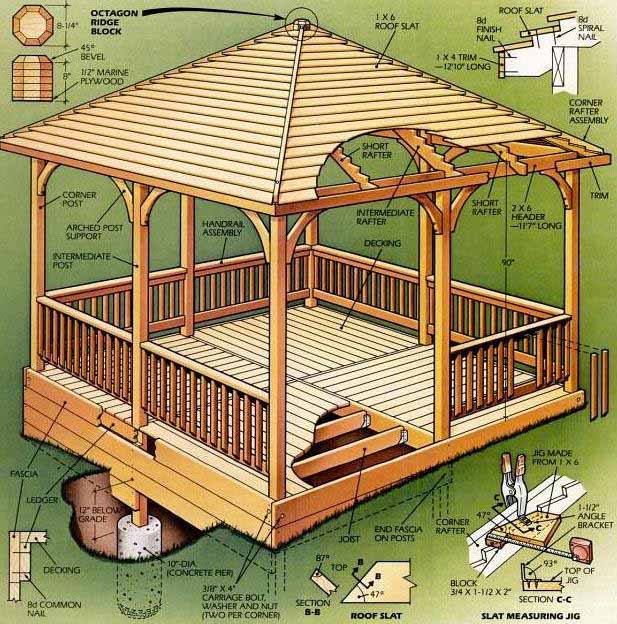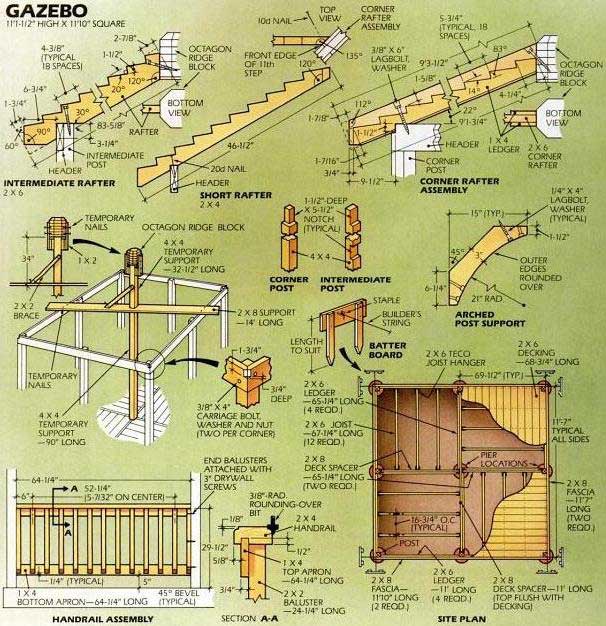Square Gazebo Blueprint Diagram 1
Here are some free step by step DIY square gazebo plans and blueprints for building a beautiful square gazebo.
Step #1 : Let’s Get Started
1) Decide the location for building you gazebo and mark the position of one of the corner posts by pushing a batter board into the ground near the spot. A batter board is a setup of boards that are driven into the ground for marking the corners of a building and have fastened strings which locate the position of the walls. The legs of the batter board are sharpened so that they can be pushed into the ground (refer to the square gazebo plans diagram 1) quite easily. Drive a strong staple or nail into the batter board’s support and tie a string to it.
2) Batter boards do not really mark the precise position of the gazebo’s corners, but rather are located a small distance away from allowing you room to dig the earth. The junction of the layout strings represent the outward faces of the corner posts. These strings also show the position for the top of the deck. The deck is positioned so it is about 5 inches above ground level.
3) Mark one side of the gazebo with a tape and drive a second batter board into the ground. Using a line level stretch the string from first to second batter board adjusting the string to be level. Mark the remaining sides of the gazebo in a similar manner. Adjust the location of the batter boards to make sure they are reasonably square to each other.
4) Diagonally measure across the strings and check to see that layout is properly square. Carve into the ground about 4 inches outside of the strings to mark the perimeter of the gazebo. Remove one string temporarily and then remove the dirt and dig the ground inside of the perimeter. Mark the positions for the corner posts with stakes. Pull the strings from the four corners to find the center and mark the position of the central pier.
5) Dig the holes for the posts of about 10 inches diameter and 3 feet deep. Lay a few inches of gravel at the bottom of each hole. Pour concrete into the holes 2 feet deep and 1 feet below the ground level.
6) Putting the posts on the footing instead of setting them directly into the wet concrete enables you to move the posts such that they are perfectly square to one another. If the posts become out of square, or they are at different heights, then it will be hard to make the rafters fit correctly.
Square Gazebo Blueprint Diagram 2
Step #2 : Laying the Posts & Joists
1) Cut the 4 headers to the same exact length using a circular saw. Then with the saw positioned at 45 degrees bevel their ends. Don’t cut the corner posts, rather position them overhanging on the footings and brace them with a pair of 2 x 3 s. Attach the strings back to the batter boards and align the posts with the help of the strings. The strings must barely touch the outside of the posts.
2) Using the strings mark the outside faces on one post and also mark the header position. For extending the marks of the header to the other 3 posts, put a level on a 14 feet long 1×4 and make use of its straight edges to mark the posts which are adjacent to it. Recheck the height of the header by using the strings. Lastly, mark the position where the strings meet the posts which marks the upper face of the deck.
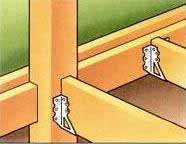 3) Bring down two posts and crosscut them to the same length. Then cut out the rabbet for placing the header using a dado blade inside a radial arm saw. Drill the bolt holes for fixing the header, test fitting the header, then remove it and put up the two posts. Line the posts using the string and bolt the header into its place. Now repeat this again for the other two opposite posts and set up the two remaining headers.
3) Bring down two posts and crosscut them to the same length. Then cut out the rabbet for placing the header using a dado blade inside a radial arm saw. Drill the bolt holes for fixing the header, test fitting the header, then remove it and put up the two posts. Line the posts using the string and bolt the header into its place. Now repeat this again for the other two opposite posts and set up the two remaining headers.
4) Cut the fascia boards to length and bolt the boards to the posts. The upper edge of the fascia board on top should be level with the deck of the gazebo. Make one last check that the posts are square and adjust them as needed. Fill the post holes with dirt and pack the dirt down.
5) Crosscut the wooden ledgers. Cut 2 x 2 out of some lumber and fix it to the top of the fascia. This will enable you to better position the ledger. Lay the ledger below the 2 x 2 and nail the ledger to the fascia.
6) Put up the intermediate posts inside their holes. Mark the position for the rabbet where it meets the header and mark the position for the dado where it meets the ledger. Crosscut, dado and rabbet the posts. Stand up the posts and verify they are straight, then bolt them into place. Fill their holes and press down the dirt. Use a handsaw, to cut the bevel outside of the header miters for clearing a space to make the bird’s mouth cut close to the end of the rafters.
7) Nail down the remaining fascia boards to match the height of the deck. Fill dirt against the fascia boards and pack the soil down. As the fascia is many boards deep, nail down vertical support pieces on to the back of the fascia boards halfway in between the corner and the intermediate posts. This will help to keep the face of the fascia boards flush. The vertical supports can be ignored if the fascia is only 1 or 2 boards in height.
8) Setup 1 long floor joist and 2 short 2 x 8 floor joists by nailing joist hangers to the centers of intermediate posts. The joists separate the deck into 4 quadrants which are referred to as deck spacers. The tops of the joists are plumb with the decking. Finish the floor framing by nailing down the ledgers to the short and long joists. Now, nail the other joists in their place with joist hangers.
Step #3 : Building the Deck
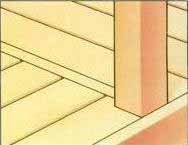 1) Measure the deck boards a bit oversize then cut and lay them down over the joists. Use a pencil to mark across the edge of the deck boards including the inner edge of the fascia. Cut them to fit tightly along the fascia and deck floor joists. Using a fine tooth saw helps to get a smooth edge while cutting.
1) Measure the deck boards a bit oversize then cut and lay them down over the joists. Use a pencil to mark across the edge of the deck boards including the inner edge of the fascia. Cut them to fit tightly along the fascia and deck floor joists. Using a fine tooth saw helps to get a smooth edge while cutting.
2) Notch the boards which go around the posts. Nail down the deck boards at each joist using a pair of spiral shank nails. Drill the holes for the nails close to the ends of the boards before nailing so that the wood doesn’t split. Leave about 1/4 inch space between the boards.
3) Apply few coats of water sealer once the deck is completed. Once the sealer has dried off, cover the deck with some tarp to protect it from falling pieces of wood during the framing of the roof.

Step #4 : Constructing the Roof
1) Start the roof building by constructing the octagonal ridge block. As shown in the diagram 1 of the square gazebo plans, the ridge block is made up using six layers of 2 x 10 s glued to each other with waterproof glue. The bottom of the block is sealed using a piece of 1/2 inch thick plywood.
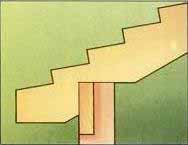 2) For test fitting the rafters, you must position the ridge block exactly as it would be once the roof is completed. For doing this, make a support as shown in the diagram 2 of the square gazebo plans. Start by cutting the short 1 x 1 post, then nail the octagon support to it. Lay the octagon ridge block on the support and then drive many nails through the support into the ridge block. Drive the nails such that enough of their heads are outside for pulling them out later on.
2) For test fitting the rafters, you must position the ridge block exactly as it would be once the roof is completed. For doing this, make a support as shown in the diagram 2 of the square gazebo plans. Start by cutting the short 1 x 1 post, then nail the octagon support to it. Lay the octagon ridge block on the support and then drive many nails through the support into the ridge block. Drive the nails such that enough of their heads are outside for pulling them out later on.
3) Lay down a 2 x 8 across the headers and nail it down. Drop a straight line down from the 2 x 8 and find the center of your gazebo. Mark this center on the deck plank. Place the short post centered on the gazebo, then nail from beneath the 2 x 8 into the post bottom. Secure the short post with a piece of 2 x 2 while supporting it from below using a 4 x 4 post toe-nailed to the bottom of the 2 x 8.
4) Cut four 2 x 6 rafters for the corners, and eight 1 x 4 nailer boards, as shown in the rafter patterns in diagram 2 of the square gazebo plans. Using a heavy cardboard pattern, trace the steps in the nailer boards. The rafters along with the nailer boards are nailed together forming the corner rafter assembly.
5) You cannot test fit a rafter assembly alone. The corner rafter assembly tends to be unwieldy and its is better if it is handled by at least two people. If the roof components don’t fit together exactly, you will need to shim or notch them as needed for fitting the pieces.
6) Drill a hole for a 3/8 inch x 6 inch lagbolt close to the top of every rafter. Now, fix the rafter assembly to the ridge block using a lagbolt and fender washer beneath the bolt head. Once the lagbolts are tightened, use silicone caulk to fill the holes. Repeat this process for attaching the rafters on top of the corner posts. You can now remove the supports which are holding the ridge block up.
7) Cut the intermediate rafters out according to the rafter plans. Use a template for tracing the steps. Notice in the drawing, the short and intermediate rafters are placed beneath the corner rafter assembly for accommodating the roof slats. The short rafters are build using 2 x 4 s. Their upper edges are beveled to assemble with the corner rafter assembly. Cut the 4 corner rafters out using the bevel in 1 direction and 4 with the bevel facing opposite.
8) The intermediate rafters are bolted to the ridge block and the header. Short rafters are nailed to the corner rafter assembly. Make sure that the short rafters are exactly parallel to the intermediate rafter, and adjust them as needed. Nail them to the header and corner rafter assembly.
Step 5 : Making the Roof Slats
1) The roof slats are measured and cut in batches for each roof facet before they are nailed into place. For doing this, make use a pair of slat-measuring jigs as seen in drawing 1 of the square gazebo plans. The jigs are clamped to every corner rafter. A tape is pulled from the tip of one jig to the tip of the other for measuring the outer lower comers of each slat.
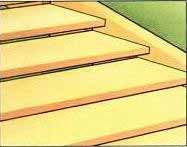 2) Cut the angle on the end of every slat as seen in drawing 1 and test by fitting the slats to the corner rafter assembly. Trim or chisel the slats as needed to get them to fit. accurately. Beginning at the bottom, start attaching each slat to the rafter using a pair of galvanized spiral shank nails driven into pre-drilled holes using 2 nails per rafter.
2) Cut the angle on the end of every slat as seen in drawing 1 and test by fitting the slats to the corner rafter assembly. Trim or chisel the slats as needed to get them to fit. accurately. Beginning at the bottom, start attaching each slat to the rafter using a pair of galvanized spiral shank nails driven into pre-drilled holes using 2 nails per rafter.
3) Miter and cross-cut the cedar trim boards. Drill the nail holes close to their ends for preventing the slats from splitting. Nail them to the rafter ends using galvanized nails. Once completed, coat the roof and fascia using two coats of water sealer both underneath and on top.
Step #6 : Building the Railings
1) Cut the aprons and handrails so that they fit in between their respective posts. Cut an apron groove beneath each handrail with the help of dado blades in a radial arm saw. Using a router and 3/8 inch radius rounding over bit, cut a beautiful decorative profile on the upper edges of the railings.
2) Cut the balusters so that they have one end beveled. Use clamps and waterproof glue and fasten the top apron to the handrail. Place the balusters as shown in the figure attaching them to the aprons using a pair of galvanized nails driven into every apron. Using a framing square square each baluster to the apron making sure that the beveled end is at the bottom and is facing the outside of the railing. Fix all but the last and first balusters with the aprons.
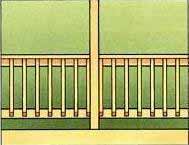 3) Screw the remainder of the balusters to the intermediate and corner posts and attach the handrail assembly to them. Fasten the balusters to the posts 1 3/8 inches from the front of the posts. Drill pilot holes through the balusters for driving 3 inch galvanized dry wall screws.
3) Screw the remainder of the balusters to the intermediate and corner posts and attach the handrail assembly to them. Fasten the balusters to the posts 1 3/8 inches from the front of the posts. Drill pilot holes through the balusters for driving 3 inch galvanized dry wall screws.
4) The handrail assembly is then hung on to the balusters. Drill a pilot hole through the upper apron into the end balusters and drill two holes through the bottom apron. The balusters are secured to the handrail assembly using 2 inch galvanized dry wall screws.
5) Build a template using arched post support brackets. Draw the pattern on a piece of 2 x 6 cedar and cut the brackets out with a sabre saw. Sand the saw marks out.
6) Holding the brackets to the posts drill a pair of 5/6 inch diameter pilot holes in every brackets. Use washers and lagbolts, fasten the brackets to their posts.




